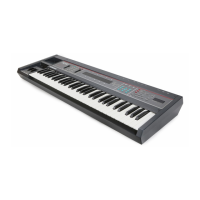SQ-80 — Musician's Manual
note can be played at a time. Priority is given to the
last note played — even if another note is
being held down, the most recent note you play will sound. However, the envelope will not be
re-triggered by striking a key as long as any other key is held down.
Mono mode on the SQ-80
does not stack all eight voices on one key — only one voice plays.
5. GLIDE
Also called Portamento. This causes the pitch of the Oscillators to "glide" between notes instead
of the usual abrupt transition. The higher the value, the longer it will take to get from the pitch
of the first note played to that of the second. Range:
0 To 63.
Note: The GLIDE function behaves in one of two ways, depending on whether or not MONO mode is
engaged:
With MONO mode OFF: The pitch of any note played will 'glide' to its proper pitch from that
of the note played by that voice immediately before it, at the rate that has been set. In this mode
the
GLIDE is polyphonic, and whole chords can be made to swoop up and down together. (Very
dramatic.)
With MONO mode ON:
You have what is called Fingered Portamento. If a key is pressed with
no other keys held down, there is no
GLIDE. If you then play a second key while holding down
the first, the note will glide from the pitch of the first key to that of the second. Release the second
key (still holding the first one down) and it glides back. In other words,
the effect is only present
when a note is played while another key is held down. You can thus play Staccato for runs
without
GLIDE, and Legato for runs with GLIDE.
Note: The next two Parameters (#7, [VC] VOICE Restart, and #8, [ENV] ENVELOPE Restart)
affect only what happens when you play the same note twice in succession.
7. VC —VOICE Restart
When ON: If the same key is restruck before the note has died away, it will be assigned the same
Voice that was previously playing it. That Voice will be 'stolen' to play the new note. This is
fine for many sounds, such as piano, but it can be annoying with others, especially sounds with
long Attack or Release times, like strings, where you don't necessarily want a note to abruptly
disappear just because you have played the same note again.
When OFF:
If a key is restruck before the note has died away, a new Voice will be assigned to
it, and the first Voice will continue to play. If there are already two Voices playing that note, the
older of the two is 'stolen'. (Two Voices will alternate playing the note if it is struck repeatedly.)
As mentioned above, for sounds with long Attack or Release times (such as long filter sweeps,
etc.) this is often better.
8. ENV —ENVELOPE Restart
When ON: If the same key is restruck, all four Envelopes will reset, and start their cycles at Zero
level.
When OFF:
Each Envelope will start its cycle at its present level, regardless of what that level
is, when the same note is played again. It will then take
TIME 1 to reach LEVEL 1, whether the
new ramp is in the same direction (up or down) as the original attack segment or not. In other
words, each Envelope behaves normally, except that its
Starting Level, normally Zero, becomes
whatever Level it was at when the key was restruck.
Section 3 — Voice Programming
69

